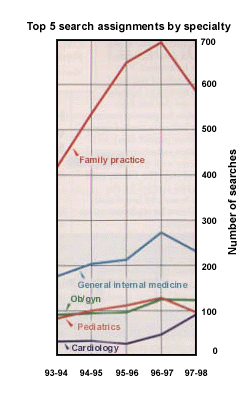
Fam Pract Manag. 1998;5(8):33-34
Aetna, physicians embattled again
The most recent of several battles between Aetna U.S. Healthcare and Texas physicians flared up on July 12, when Genesis Physicians Practice Association, a 750-member IPA in north Texas and part of Presbyterian Healthcare System, terminated its contract with Aetna. The physicians allege that Aetna's HMO withheld important financial and clinical data that would have helped the physicians practice more efficiently. They also objected to a clause in Aetna's contract that would have required the physicians to service all of Aetna's products or none. Had the all-or-none clause not been in place, Genesis physicians say they would continue to service Aetna's PPO and point-of-service plans.
Genesis' walk-out came one day after Aetna threatened to terminate its contract with the group as of Oct. 10. Aetna may now seek to contract with individual physicians. If the parties don't get back together, an estimated 38,000 Aetna patients will have to switch plans or doctors by mid-October, when the termination takes effect.
Last fall, 250 physicians in the Dallas area threatened to quit Aetna when their fees were cut by as much as 40 percent. Earlier this year, Methodist Hospital of Dallas threatened to quit Aetna's network if it could not settle a payment conflict with its physicians. Both disputes were eventually resolved.
Primary care recruitment slows; family practice remains on top
According to a recent report by a national health care staffing firm, the number of searches it conducted for primary care physicians dropped 17 percent last year, while searches for physicians in other specialties increased by 40 percent. The number of primary care searches decreased for the first time in the survey's five-year history.
“This is the most significant turnabout in the medical job market since managed care put primary care physicians in the driver's seat in the early 1990s,” says Joseph Hawkins, CEO of Merritt, Hawkins and Associates, the Dallas-based firm that conducted the survey. “It demonstrates again the futility of predicting physician supply and demand in today's mercurial medical market.”
Merritt attributes the drop in part to the recent managed care backlash, which has led consumers to demand increased access to specialists in fields other than primary care. He also suggests that because many organizations recruited primary care physicians aggressively in the past five years, they might now be rounding out their panels with other specialists.
The survey does offer some good news for family physicians. While family physician searches are indeed down from previous years, family practice continues to lead all other specialties in number of searches. Moreover, the average income offered to family physicians was $132,000, up $3,000 from last year.

Hospitalists' care shown to lower costs
A recent study found that in one year, the use of hospitalists reduced the average length of stay and saved more than $1 million in care-related costs for a community teaching hospital.
The study, published in Annals of Internal Medicine, examined cost and utilization data for all patients admitted to the hospital by one primary care group during the first year of the facility's use of hospitalists and compared it with similar data for all patients that the group admitted to the facility in the previous year. Two other comparison groups were also studied to avoid selection bias.
For patients in the hospitalist group, the median cost of care was $3,552, 14 percent less than the median cost for patients treated without hospitalists. The median length of stay for patients treated by hospitalists was one day less than the median for patients treated the year before (a total of almost 4,000 fewer patient days), and the greatest reductions occurred for patients with the longest lengths of stay. The 14-day readmission rate also fell for the patients treated by hospitalists, from 9.9 to 4.64 readmissions per 100 admissions.
Although the authors note that the hospitalists had no financial incentive to reduce the cost of care or lengths of stay, “it was understood that these reductions would become a goal of the program.”
How to help seniors with questions about Medicare+Choice
This fall Medicare beneficiaries will begin receiving educational materials from HCFA about Medicare+Choice coverage options, and many will turn to their family physicians with questions. You may want to direct patients to one of the health insurance counseling programs that have been set up to help beneficiaries understand the changes. A list of the programs and their phone numbers, most of which are toll-free, is available at the AAFP web site, https://www.aafp.org/medicare. AAFP members can also obtain a free copy of the list by fax by calling 800-223-7397. You'll need to enter your member identification number and document number 5000.
For answers to basic Medicare questions and to access a database that allows users to search by ZIP code for comparative information about health plans in their areas, visit http://www.medicare.gov/comparison on the World Wide Web. The site also features the full text of the “Medicare and You” booklet that explains beneficiaries' full range of Medicare+ Choice options. Because of funding limitations, HCFA will mail the booklet to enrollees in just five states this fall. Others will receive an abbreviated booklet.
Quote. End quote.
“If a package delivery person can track letter delivery by the minute, if a grocer can update the sales rate of cereal daily, if a managed care organization can track the use of beta-blockers for acute myocardial infarction, then it is reasonable to expect medical professionals to track their results. ... Physicians who ignore the measurement issue invite someone else to manage their profession. Simply stated, physicians should do it for themselves or have it done to them.”
Lee N. Newcomer, MD, chief medical officer of United HealthCare Corp. in Minnetonka, Minn., writing in Health Affairs on the need for physician performance measurement.